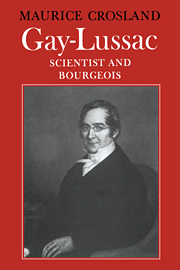Book contents
- Frontmatter
- Contents
- Preface
- Chronological table
- List of abbreviations
- 1 A young provincial in Paris
- 2 The apprentice of Arcueil
- 3 Personal influences and the search for laws
- 4 Collaboration and rivalry
- 5 The volumetric approach
- 6 Scientific research
- 7 Professor, Academician and editor
- 8 A scientist in the service of government and industry
- 9 A new technique and the dissemination of technical information
- 10 Scientist and bourgeois in the political arena
- 11 The legacy
- Appendix: select correspondence
- Notes
- Select bibliography
- Name index
- Subject index
5 - The volumetric approach
Published online by Cambridge University Press: 03 November 2009
- Frontmatter
- Contents
- Preface
- Chronological table
- List of abbreviations
- 1 A young provincial in Paris
- 2 The apprentice of Arcueil
- 3 Personal influences and the search for laws
- 4 Collaboration and rivalry
- 5 The volumetric approach
- 6 Scientific research
- 7 Professor, Academician and editor
- 8 A scientist in the service of government and industry
- 9 A new technique and the dissemination of technical information
- 10 Scientist and bourgeois in the political arena
- 11 The legacy
- Appendix: select correspondence
- Notes
- Select bibliography
- Name index
- Subject index
Summary
‘Gay-Lussac and the leading French chemists adopt the language of volumes combining’
John Dalton (1830)Gay-Lussac's most important pieces of research were either concerned with gases and their volumes or with preparative chemistry which involved volatile compounds such as hydrogen iodide and hydrogen cyanide. His volumetric approach was fundamental, a leitmotif which reappeared throughout his research and particularly in his most creative years from 1802 until the early 1830s. We shall see that it constituted at the same time an enormous strength and also a great weakness. On the one hand Gay-Lussac discovered fundamental volumetric laws and used them imaginatively in probing the mysteries of chemical composition. However, once committed to volumes as the language of experience, he was insensitive to the possibilities of an alternative gravimetric viewpoint.
The volumetric approach to matter of Gay-Lussac and his successors could easily be overlooked today. Yet as one of the principal methods of investigating the basic problems of chemical composition and reactions, it influenced much of the chemistry of the first half of the nineteenth century. When there were so few keys to the understanding of physical and chemical units, it provided a valuable means of approach and one which could claim to be solidly based on experimental evidence. In any sketch of the history of chemistry, writers tend to pass directly from Dalton and Avogadro (1808, 1811) to the acceptance of a standard system of atomic weights at the Karlsruhe conference half a century later.
- Type
- Chapter
- Information
- Gay-LussacScientist and Bourgeois, pp. 92 - 114Publisher: Cambridge University PressPrint publication year: 1978



